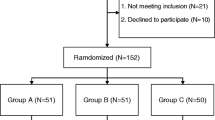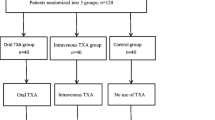Abstract
Introduction
A frequent complication after total hip arthroplasty is bleeding; to reduce it, intravenous or intra-articular tranexamic acid (TXA) is used. There is no evidence yet on which route of administration is better.
Materials and method
This was a prospective, controlled, randomized study in 2 arms between February 2017 and February 2019. In group A, 15 mg/kg intravenous TXA was administered and in group B 2 g intra-articular TXA. Haemoglobin and haematocrit values were evaluated at 24–72 h, also volume of drained blood, volume of blood lost, transfusions and complications.
Results
A total of 195 patients were included: 110 in group A and 85 group B. Haemoglobin dropped 3.10 ± 1.32 g/dl in 24 h and 3.63 ± 1.41 g/dl at 72 h in group A; the haematocrit dropped 8.38 ± 4.67% in 24 h and 15.40 ± 4.39% in 72 h. In group B, haemoglobin dropped 3.09 ± 1.40 g/dl in 24 h and 3.34 ± 1.23 g/dl in 72 h and haematocrit 9.75 ± 3.95% and 10.40 ± 3.72% in 24 and 72 h. No significant differences were found for haemoglobin values at 24 and 72 h and haematocrit at 24 h (p > 0.05); we did not obtain statistically significant differences in drainage, blood loss between groups or in the proportion of transfused. When stratifying the results by age, we obtained significant differences in the decrease in haemoglobin (p = 0.021) and haematocrit (p = 0.025) in patients > 65 years.
Conclusions
The different routes of administration of TXA in PTC have a similar effect in reducing post-operative bleeding without evidencing an increase in complications.
Level of evidence
I.

Similar content being viewed by others
References
Chen Y, Chen Z, Cui S, Li Z, Yuan Z (2016) Topical versus systemic tranexamic acid after total knee and hip arthroplasty: a meta-analysis of randomized controlled trials. Med (Baltimore) 95(41):e4656
Levine BR, Haughom B, Strong B, Hellman M, Frank RM (2014) Blood management strategies for total knee arthroplasty. J Am Acad Orthop Surg 22(6):361–371
Carson JL, Duff A, Poses RM, Berlin JA, Spence RK, Trout R et al (1996) Effect of anaemia and cardiovascular disease on surgical mortality and morbidity. Lancet 348(9034):1055–1060
Hart A, Ja K, Carli A, Huk O, Zukor D, Antoniou J (2014) Blood transfusion in primary total hip and knee arthroplasty. Incidence, risk factors, and thirty-day complication rates. J Bone Jt Surg Am 96(23):1945–1951
Sarzaeem MM, Razi M, Kazemian G, Moghaddam ME, Rasi AM, Karimi M (2014) Comparing efficacy of three methods of tranexamic acid administration in reducing hemoglobin drop following total knee arthroplasty. J Arthroplasty 29(8):1521–1524
Spahn DR (2010) Anemia and patient blood management in hip and knee surgery: a systematic review of the literature. Anesthesiology 113(2):482–495
Canillas F, Gómez-Ramírez S, García-Erce JA, Pavía-Molina J, Gómez-Luque A, Muñoz M (2015) “Patient blood management” in orthopaedic surgery. Rev Esp Cir Ortop Traumatol 59(3):137–149
Ngichabe S, Obura T, Stones W (2015) Intravenous tranexamic acid as an adjunct haemostat to ornipressin during open myomectomy. Ann Surg Innov Res 31(9):10
Fillingham YA, Ramkumar DB, Jevsevar DS, Yates AJ, Bini SA, Clarke HD et al (2018) Tranexamic acid use in total joint arthroplasty: the clinical practice guidelines endorsed by the American association of hip and knee surgeons, American Society of Regional Anesthesia and Pain Medicine, American Academy of Orthopaedic Surgeons, Hip Society, and Knee Society. J Arthroplasty 33(10):3065–3069
Chang C, Chang Y, Chen DW, Ueng SW, Lee MS (2014) Topical tranexamic acid reduces blood loss and transfusion rates associated with primary total hip arthroplasty. Clin Orthop Relat Res 472(5):1552–1557
Liu X, Liu J, Sun G (2017) A comparison of combined intravenous and topical administration of tranexamic acid with intravenous tranexamic acid alone for blood loss reduction after total hip arthroplasty: a meta-analysis. Int J Surg 41:34–43
Yue C, Kang P, Yang P, Xie J, Pei F (2014) Topical application of tranexamic acid in primary total hip arthroplasty: a randomized double-blind controlled trial. J Arthroplasty 29(12):2452–2456
Soni A, Saini R, Gulati A, Paul R, Bhatty S, Rajoli SR (2014) Comparison between intravenous and intra-articular regimens of tranexamic acid in reducing blood loss during total knee arthroplasty. J Arthroplasty 29(8):1525–1527
Patel JN, Spanyer JM, Smith LS, Huang J, Yakkanti MR, Malkani AL (2014) Comparison of intravenous versus topical tranexamic acid in total knee arthroplasty: a prospective randomized study. J Arthroplasty 29(8):1528–1531
Hourlier H, Fennema P (2014) Single tranexamic acid dose to reduce perioperative morbidity in primary total hip replacement: a randomised clinical trial. Hip Int 24(1):63–68
Barrachina B, Lopez-picado A, Remon M, Fondarella A, Iriarte I, Bastida R et al (2016) Tranexamic acid compared with placebo for reducing total blood loss in hip replacement surgery: a randomized clinical trial. Anesth Analg 122(4):986–995
Goto Koji et al (2016) Topical tranexamic acid reduces postoperative blood loss in patients undergoing primary total hip arthroplasty with the drain-clamping. EC Orthop 3(3):314–321
De Leon EM, Szallasi A (2014) “Transfusion indication RBC (PBM-02)”: gap analysis of a joint commission patient blood management performance measure at a community hospital. Blood Transfus 12(Suppl 1):s187–s190
American Society of Anesthesiologists (2014) American Society of Anesthesiologists: ASA Physical Status Classification System. American Society of Anesthesiologists. https://www.asahq.org/standards-and-guidelines/asa-physical-status-classification-system. Accessed 2 Mar 2019
Aguilera-roig X, Jordán-sales M, Natera-cisneros L, Monllau-garcía JC, Martínez-Zapata MJ (2014) Ácido tranexámico en cirugía ortopédica. Rev Esp Cir Ortop Traumatol 58(1):52–56
Melvin JS, Stryker LS, Sierra RJ (2015) Tranexamic acid in hip and knee. J Am Acad Orthop Surg 23(12):732–740
Abrishami A, Chung F, Wong J (2009) Topical application of antifibrinolytic drugs for on-pump cardiac surgery: a systematic review and meta-analysis. Can J Anaesth 56(3):202–212
Zhang P, Liang Y, Chen P, Fang Y, He J, Wang J (2016) Intravenous versus topical tranexamic acid in primary total hip replacement: a meta-analysis. Med (Baltimore) 95(50):e5573
Luo ZY, Wang HY, Wang D, Zhou K, Pei FX, Zhou ZK (2018) Oral vs intravenous vs topical tranexamic acid in primary hip arthroplasty: a prospective, randomized, double-blind, controlled study. J Arthroplasty 33(3):786–793
Digas G, Koutsogiannis I, Meletiadis G, Antonopoulou E, Karamoulas V, Bikos Ch (2015) Intra-articular injection of tranexamic acid reduce blood loss in cemented total knee arthroplasty. Eur J Orthop Surg Traumatol 25(7):1181–1188
Gortemoller MA, Allen B, Forsyth R, Theiss K, Cunningham K, Tucker C (2018) Comparison of oral and intravenous tranexamic acid for prevention of perioperative blood loss in total knee and total hip arthroplasty. Ann Pharmacother 52(3):246–250
Luo ZY, Wang D, Meng WK, Wang HY, Pan H, Pei FX et al (2018) Oral tranexamic acid is equivalent to topical tranexamic acid without drainage in primary total hip arthroplasty: a double-blind randomized clinical trial. Thromb Res 167:1–5
Lin PC, Hsu CH, Huang CC, Chen WS, Wang JW (2012) The blood-saving effect of tranexamic acid in minimally invasive total knee replacement: is an additional pre-operative injection effective? J Bone Jt Surg Br 94(7):932–936
Nadler SB, Hidalgo JH, Bloch T (1962) Prediction of blood volume in normal human adults. Surgery 51(2):224–232
Gross JB (1983) Estimating allowable blood loss: corrected for dilution. Anesthesiology 58(3):277–280
Funding
This work has not required funding from any private or public organization or company.
Author information
Authors and Affiliations
Corresponding author
Ethics declarations
Conflict of interest
The authors declare that they have no conflict of interest.
Additional information
Publisher's Note
Springer Nature remains neutral with regard to jurisdictional claims in published maps and institutional affiliations.
Appendices
Appendix 1 [29]
-
Men: K1 = 0.3699/K2 = 03219/K3 = 0.6041
-
Women: K1 = 0.3561/K2 = 0.03308/K3 = 0.1833.
Appendix 2 [30]
Appendix 3 [20]
Rights and permissions
About this article
Cite this article
Gómez-Aparicio, M.d.S., Gómez-Barbero, P., Blas-Dobón, J.A. et al. Results after the application of tranexamic acid intravenous or intra-articular in the control of postsurgical bleeding after total hip arthroplasty: a randomized controlled trial. Eur J Orthop Surg Traumatol 30, 1221–1230 (2020). https://doi.org/10.1007/s00590-020-02688-1
Received:
Accepted:
Published:
Issue Date:
DOI: https://doi.org/10.1007/s00590-020-02688-1




